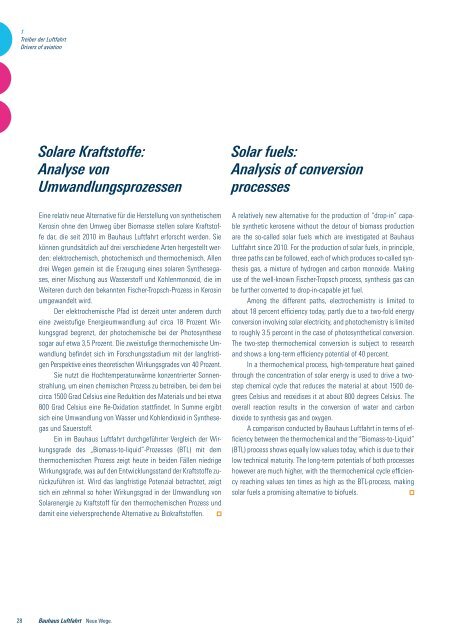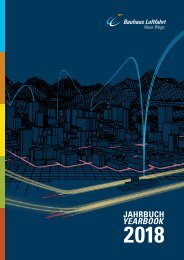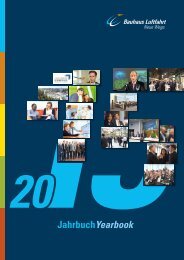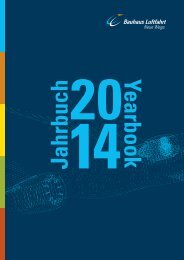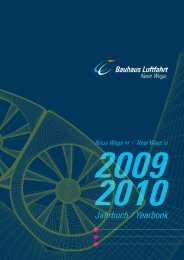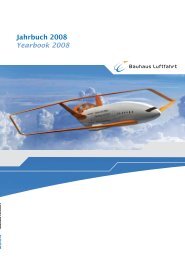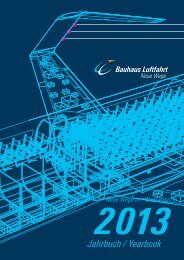o_195dtc73e123o1gt5s461nc0qria.pdf
Sie wollen auch ein ePaper? Erhöhen Sie die Reichweite Ihrer Titel.
YUMPU macht aus Druck-PDFs automatisch weboptimierte ePaper, die Google liebt.
1<br />
Treiber der Luftfahrt<br />
Drivers of aviation<br />
Solare Kraftstoffe:<br />
Analyse von<br />
Umwandlungsprozessen<br />
Solar fuels:<br />
Analysis of conversion<br />
processes<br />
Eine relativ neue Alternative für die Herstellung von synthetischem<br />
Kerosin ohne den Umweg über Biomasse stellen solare Kraftstoffe<br />
dar, die seit 2010 im Bauhaus Luftfahrt erforscht werden. Sie<br />
können grundsätzlich auf drei verschiedene Arten hergestellt werden:<br />
elektrochemisch, photochemisch und thermochemisch. Allen<br />
drei Wegen gemein ist die Erzeugung eines solaren Synthesegases,<br />
einer Mischung aus Wasserstoff und Kohlenmonoxid, die im<br />
Weiteren durch den bekannten Fischer-Tropsch-Prozess in Kerosin<br />
umgewandelt wird.<br />
Der elektrochemische Pfad ist derzeit unter anderem durch<br />
eine zweistufige Energieumwandlung auf circa 18 Prozent Wirkungsgrad<br />
begrenzt, der photochemische bei der Photosynthese<br />
sogar auf etwa 3,5 Prozent. Die zweistufige thermochemische Umwandlung<br />
befindet sich im Forschungsstadium mit der langfristigen<br />
Perspektive eines theoretischen Wirkungsgrades von 40 Prozent.<br />
Sie nutzt die Hochtemperaturwärme konzentrierter Sonnenstrahlung,<br />
um einen chemischen Prozess zu betreiben, bei dem bei<br />
circa 1500 Grad Celsius eine Reduktion des Materials und bei etwa<br />
800 Grad Celsius eine Re-Oxidation stattfindet. In Summe ergibt<br />
sich eine Umwandlung von Wasser und Kohlendioxid in Synthesegas<br />
und Sauerstoff.<br />
Ein im Bauhaus Luftfahrt durchgeführter Vergleich der Wirkungsgrade<br />
des „Biomass-to-liquid“-Prozesses (BTL) mit dem<br />
thermochemischen Prozess zeigt heute in beiden Fällen niedrige<br />
Wirkungsgrade, was auf den Entwicklungsstand der Kraftstoffe zurückzuführen<br />
ist. Wird das langfristige Potenzial betrachtet, zeigt<br />
sich ein zehnmal so hoher Wirkungsgrad in der Umwandlung von<br />
Solarenergie zu Kraftstoff für den thermochemischen Prozess und<br />
damit eine vielversprechende Alternative zu Biokraftstoffen.<br />
A relatively new alternative for the production of “drop-in” capable<br />
synthetic kerosene without the detour of biomass production<br />
are the so-called solar fuels which are investigated at Bauhaus<br />
Luftfahrt since 2010. For the production of solar fuels, in principle,<br />
three paths can be followed, each of which produces so-called synthesis<br />
gas, a mixture of hydrogen and carbon monoxide. Making<br />
use of the well-known Fischer-Tropsch process, synthesis gas can<br />
be further converted to drop-in-capable jet fuel.<br />
Among the different paths, electrochemistry is limited to<br />
about 18 percent efficiency today, partly due to a two-fold energy<br />
conversion involving solar electricity, and photochemistry is limited<br />
to roughly 3.5 percent in the case of photosynthetical conversion.<br />
The two-step thermochemical conversion is subject to research<br />
and shows a long-term efficiency potential of 40 percent.<br />
In a thermochemical process, high-temperature heat gained<br />
through the concentration of solar energy is used to drive a twostep<br />
chemical cycle that reduces the material at about 1500 degrees<br />
Celsius and reoxidises it at about 800 degrees Celsius. The<br />
overall reaction results in the conversion of water and carbon<br />
dioxide to synthesis gas and oxygen.<br />
A comparison conducted by Bauhaus Luftfahrt in terms of efficiency<br />
between the thermochemical and the “Biomass-to-Liquid”<br />
(BTL) process shows equally low values today, which is due to their<br />
low technical maturity. The long-term potentials of both processes<br />
however are much higher, with the thermochemical cycle efficiency<br />
reaching values ten times as high as the BTL-process, making<br />
solar fuels a promising alternative to biofuels.<br />
28<br />
Bauhaus Luftfahrt Neue Wege.


